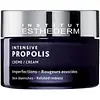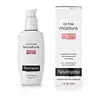What's inside
What's inside
 Key Ingredients
Key Ingredients

 Benefits
Benefits

 Concerns
Concerns

 Ingredients Side-by-side
Ingredients Side-by-side

Water
Skin ConditioningIsononyl Isononanoate
EmollientOctyldodecanol
EmollientCyclohexasiloxane
EmollientGlycerin
HumectantPropylene Glycol
HumectantCetyl Alcohol
EmollientStearyl Alcohol
EmollientGlyceryl Stearate
EmollientMethyl Methacrylate Crosspolymer
PEG-75 Stearate
Paraffinum Liquidum
EmollientCeteth-20
CleansingPhenoxyethanol
PreservativeSteareth-20
CleansingCyclopentasiloxane
EmollientXanthan Gum
EmulsifyingChlorphenesin
AntimicrobialDisodium EDTA
Propolis Extract
Skin ConditioningAminoethanesulfinic Acid
AntioxidantSilica
AbrasiveCarnosine
Skin ConditioningMethylparaben
PreservativeDisodium Adenosine Triphosphate
Skin ConditioningPropylparaben
PreservativeLaminaria Digitata Extract
Skin ProtectingWater, Isononyl Isononanoate, Octyldodecanol, Cyclohexasiloxane, Glycerin, Propylene Glycol, Cetyl Alcohol, Stearyl Alcohol, Glyceryl Stearate, Methyl Methacrylate Crosspolymer, PEG-75 Stearate, Paraffinum Liquidum, Ceteth-20, Phenoxyethanol, Steareth-20, Cyclopentasiloxane, Xanthan Gum, Chlorphenesin, Disodium EDTA, Propolis Extract, Aminoethanesulfinic Acid, Silica, Carnosine, Methylparaben, Disodium Adenosine Triphosphate, Propylparaben, Laminaria Digitata Extract
Water
Skin ConditioningCyclomethicone
EmollientCetyl Ethylhexanoate
EmollientGlycerin
HumectantCetyl Ricinoleate
EmollientStearyl Alcohol
EmollientGlyceryl Stearate
EmollientPEG-100 Stearate
Methyl Methacrylate
Glycol Dimethacrylate Crosspolymer
Lysine Carboxymethyl Cysteinate
Skin ConditioningLysine Thiazolidine Carboxylate
Skin ConditioningTocopherol
AntioxidantSilica
AbrasiveXanthan Gum
EmulsifyingMethylparaben
PreservativePropylparaben
PreservativeDiazolidinyl Urea
PreservativeBenzalkonium Chloride
AntimicrobialWater, Cyclomethicone, Cetyl Ethylhexanoate, Glycerin, Cetyl Ricinoleate, Stearyl Alcohol, Glyceryl Stearate, PEG-100 Stearate, Methyl Methacrylate, Glycol Dimethacrylate Crosspolymer, Lysine Carboxymethyl Cysteinate, Lysine Thiazolidine Carboxylate, Tocopherol, Silica, Xanthan Gum, Methylparaben, Propylparaben, Diazolidinyl Urea, Benzalkonium Chloride
Ingredients Explained
These ingredients are found in both products.
Ingredients higher up in an ingredient list are typically present in a larger amount.
Glycerin is already naturally found in your skin. It helps moisturize and protect your skin.
A study from 2016 found glycerin to be more effective as a humectant than AHAs and hyaluronic acid.
As a humectant, it helps the skin stay hydrated by pulling moisture to your skin. The low molecular weight of glycerin allows it to pull moisture into the deeper layers of your skin.
Hydrated skin improves your skin barrier; Your skin barrier helps protect against irritants and bacteria.
Glycerin has also been found to have antimicrobial and antiviral properties. Due to these properties, glycerin is often used in wound and burn treatments.
In cosmetics, glycerin is usually derived from plants such as soybean or palm. However, it can also be sourced from animals, such as tallow or animal fat.
This ingredient is organic, colorless, odorless, and non-toxic.
Glycerin is the name for this ingredient in American English. British English uses Glycerol/Glycerine.
Learn more about GlycerinGlyceryl Stearate is a mix of glycerin and stearic acid.
It is used to stabilize the mixing of water and oil ingredients. By preventing these ingredients from separating, it can help elongate shelf life. It can also help thicken the product's texture.
As an emollient, it helps soften skin and supports barrier-replenishing ingredients.
In cosmetics, Glyceryl Stearate is often made from vegetable oils or synthetically produced.
This ingredient may not be fungal-acne safe
Fun fact: The human body also creates Glyceryl Stearate naturally.
Learn more about Glyceryl StearateMethylparaben is a preservative and is a paraben. It is used to prevent the growth of fungus, mold, and other harmful bacteria. Parabens are chemicals used as preservatives in both cosmetics and food.
Methylparaben can be synthetically created. It can also be found naturally in some fruits, such as blueberries.
Oftentimes, Methylparaben is combined with other parabens to help increase the shelf life.
The safety of Methylparaben is currently being studied. While ongoing studies are looking into the safety of parabens, the results have been very mixed. Some studies have not found Methylparaben to be harmful.
Learn more about MethylparabenPropylparaben is a preservative and is a paraben with antifungal and antimicrobial properties.
This ingredient can be naturally found in plants and insects, but most of it is synthetically manufactured for human use. In cosmetics, it is usually created by reacting para-aminobenzoic acid and propanol (an alcohol).
You can usually find this ingredient in water-based products.
Parabens have come under controversy due to the claim they are hormone disruptors. Studies show conflicting results. We recommend speaking with a professional if you have any concerns.
Propylparaben is commonly found in food, medicine, and cosmetics.
Learn more about PropylparabenSilica, also known as silicon dioxide, is a naturally occurring mineral. It is used as a fine, spherical, and porous powder in cosmetics.
Though it has exfoliant properties, the function of silica varies depending on the product.
The unique structure of silica enhances the spreadability and adds smoothness, making it a great texture enhancer.
It is also used as an active carrier, emulsifier, and mattifier due to its ability to absorb excess oil.
In some products, tiny microneedles called spicules are made from silica or hydrolyzed sponge. When you rub them in, they lightly polish away dead skin layers and enhance the penetration of active ingredients.
Learn more about SilicaStearyl Alcohol is a type of fatty alcohol from stearic acid. It is a white, waxy compound used to emulsify ingredients.
Fatty Alcohols are most often used as an emollient or to thicken a product. Emollients help soothe and hydrate the skin by trapping moisture.
They are usually derived from natural fats and oils and therefore do not have the same drying or irritating effect as solvent alcohols. FDA allows products labeled "alcohol-free" to have fatty alcohols.
Learn more about Stearyl AlcoholWater. It's the most common cosmetic ingredient of all. You'll usually see it at the top of ingredient lists, meaning that it makes up the largest part of the product.
So why is it so popular? Water most often acts as a solvent - this means that it helps dissolve other ingredients into the formulation.
You'll also recognize water as that liquid we all need to stay alive. If you see this, drink a glass of water. Stay hydrated!
Learn more about WaterXanthan gum is used as a stabilizer and thickener within cosmetic products. It helps give products a sticky, thick feeling - preventing them from being too runny.
On the technical side of things, xanthan gum is a polysaccharide - a combination consisting of multiple sugar molecules bonded together.
Xanthan gum is a pretty common and great ingredient. It is a natural, non-toxic, non-irritating ingredient that is also commonly used in food products.
Learn more about Xanthan Gum